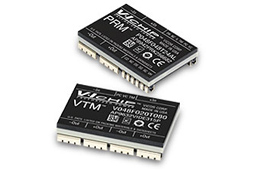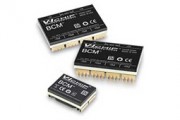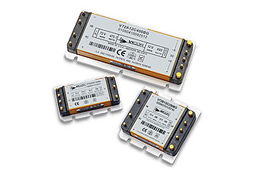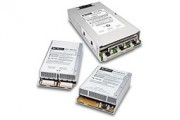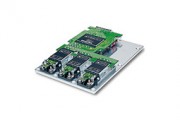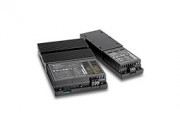Successful Applications
Advanced Distributed Architecture for ATE
 Automated test equipment systems are routinely used in avionics, transportation, and electronics manufacturing. In the semiconductor industry, automated test equipment (ATE) systems are used to test a wide range of electronic devices and systems including components such as capacitors, integrated circuits and fabricated electronic systems. Vicor engineers helped an ATE customer achieve an advanced distributed power supply architecture that delivers space savings, simplified mechanical design and other benefits.The ATE has 13 DC outputs and draws 1.2 kW from a 110 – 220 Vac mains input. The ATE electronics had previously been powered from an externally mounted centralized architecture power supply. By exploiting the high power density, efficiency and flexibility of the V•I Chip modules, the power supply assembly has now been implemented on a single board that slots directly into the ATE chassis and backplane. The board is slightly larger than a dual height, dual slot VME bus module.
Automated test equipment systems are routinely used in avionics, transportation, and electronics manufacturing. In the semiconductor industry, automated test equipment (ATE) systems are used to test a wide range of electronic devices and systems including components such as capacitors, integrated circuits and fabricated electronic systems. Vicor engineers helped an ATE customer achieve an advanced distributed power supply architecture that delivers space savings, simplified mechanical design and other benefits.The ATE has 13 DC outputs and draws 1.2 kW from a 110 – 220 Vac mains input. The ATE electronics had previously been powered from an externally mounted centralized architecture power supply. By exploiting the high power density, efficiency and flexibility of the V•I Chip modules, the power supply assembly has now been implemented on a single board that slots directly into the ATE chassis and backplane. The board is slightly larger than a dual height, dual slot VME bus module.
The move from external power supply to internal power board yielded space savings and simpler mechanical design. It also reduced cabling, with the DC outputs fed directly onto the backplane. The V·I Chip modules offer efficiencies greater than 93%, more than 5% better than previously achieved. The Micro modules supplying the higher DC voltages are also very efficient. This reduces the cooling requirement as well as energy costs – the new solution needs airflow only from the chassis cooling fan. The reduced cabling requirement has minimized issues such as radiated noise, ground loops and voltage drops. EMC filtering is also simplified.
The V·I Chip-based power design significantly enhances the test equipment’s sales features. The new equipment has twice the number of test channels of its predecessor and features additional architectural improvements.
Westcor PFC Micro is the Power Behind ATE Robotic Handlers
 Automatic test equipment (ATE) systems for the semiconductor industry typically interface with an automated placement tool, called a handler, that physically places the Device ― or Unit ― Under Test (DUT or UUT) so that it can be measured by the equipment. The handler is a robotic device used to automatically place a DUT onto an ATE system. The ‘hands’ of a robot are often referred to as end effectors, while the arm is referred to as a manipulator. Most robot arms have replaceable effectors, each allowing them to perform some small range of tasks. Some have a fixed manipulator which cannot be replaced, while a few have one very general-purpose manipulator. Also the interface can be an Interface Test Adapter (ITA). This adapter might be a device just making electronic connections between the ATE and the UUT, but also it might contain circuitry to adapt signals between the ATE and the UUT.
Automatic test equipment (ATE) systems for the semiconductor industry typically interface with an automated placement tool, called a handler, that physically places the Device ― or Unit ― Under Test (DUT or UUT) so that it can be measured by the equipment. The handler is a robotic device used to automatically place a DUT onto an ATE system. The ‘hands’ of a robot are often referred to as end effectors, while the arm is referred to as a manipulator. Most robot arms have replaceable effectors, each allowing them to perform some small range of tasks. Some have a fixed manipulator which cannot be replaced, while a few have one very general-purpose manipulator. Also the interface can be an Interface Test Adapter (ITA). This adapter might be a device just making electronic connections between the ATE and the UUT, but also it might contain circuitry to adapt signals between the ATE and the UUT.
One of our customers manufactures robotic handling equipment for the semiconductor industry. They have delivered many different automation solutions often using the same Vicor power solution. They have been a steady user of the Westcor PFC Micro, an ultra low-profile switching power supply that combines the advantages of power-factor correction (PFC) and high power density. It provides up to six isolated outputs (from two slots). For a number of robotic handlers the PFC Micro provided five outputs using three different modules: one Maxi (375 Vin, 48 Vout, 500 W), two Minis (375 Vin, 5 and 24 Vout, 135 and 25 W), and two VI-J00s (each 15 Vin, 5.5 Vout, 50 W).
Spectrographic Instruments Use VIPAC AC-DC Power Supply Configured on PowerBench
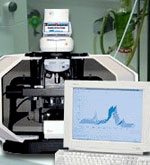 The James Webb Space Telescope, to be launched in 2014, will be in an orbit synchronous with Earth, which will act as a shield to block infrared radiation from the Sun. The telescope will use its near-infrared spectrograph to observe the most distant objects in the universe. At the other end of the scale, spectroscopy is used to analyze microscopic samples of cells and proteins. Spectrometers are even used during surgery to monitor respiration and anesthetic gases in real time.
The James Webb Space Telescope, to be launched in 2014, will be in an orbit synchronous with Earth, which will act as a shield to block infrared radiation from the Sun. The telescope will use its near-infrared spectrograph to observe the most distant objects in the universe. At the other end of the scale, spectroscopy is used to analyze microscopic samples of cells and proteins. Spectrometers are even used during surgery to monitor respiration and anesthetic gases in real time.
Our customer is a leading manufacturer of spectrographic instruments for use in such applications as astronomy, pharmaceutical and chemical manufacturing, and nanotechnology. For the current application, they make instruments that monitor chemical levels in various pharmaceutical and petro-chemical processes. These instruments employ lasers and cameras that need to be operated from voltages of 12 Vdc and 5 Vdc.
The subject application required AC inputs of 115 V and 230 V and the two DC outputs, 12 V at 200 W and 5 V at 50 W. The Vicor application engineer configured a VIPAC Power system for them using the PowerBench VIPAC Design Center. The autoranging VIPAC AC-DC power supply provides built-in EMI filtering (EN55022 compliant) that ensures the quiet operation desirable in these sensitive instruments. With no NRE, the cost of customization was decreased to that of standard solutions. Other benefits for them were the low profile of the VIPAC and the fact that it could be attached to the heat sink and the heat sink can be mounted outside of the chassis for better heat dissipation.
Pharmaceutical, Biotech, and Diagnostic Testing Laboratories Rely on Robots Powered by FlatPAC AC-DC Switchers
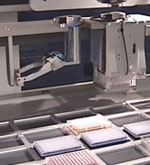 The first digitally operated and programmable robot was installed in 1961 to lift hot pieces of metal from a die casting machine and stack them. Today, robots are in widespread use performing jobs cheaper or more accurately and reliably than humans in many commercial, industrial, and even laboratory environments. Generally, the field of laboratory automation comprises many different automated laboratory instruments devices, software algorithms, and methodologies used to enable, expedite, and increase the efficiency and effectiveness of scientific research in laboratories. The application of technology in today’s laboratories is required to achieve timely progress and remain competitive. Laboratories devoted to activities such as automated clinical and analytical testing, diagnostics, and many others, would not exist without laboratory automation.
The first digitally operated and programmable robot was installed in 1961 to lift hot pieces of metal from a die casting machine and stack them. Today, robots are in widespread use performing jobs cheaper or more accurately and reliably than humans in many commercial, industrial, and even laboratory environments. Generally, the field of laboratory automation comprises many different automated laboratory instruments devices, software algorithms, and methodologies used to enable, expedite, and increase the efficiency and effectiveness of scientific research in laboratories. The application of technology in today’s laboratories is required to achieve timely progress and remain competitive. Laboratories devoted to activities such as automated clinical and analytical testing, diagnostics, and many others, would not exist without laboratory automation.
The Vicor customer is a manufacturer of robotic systems that automate functions for pharmaceutical, biotech, and diagnostic testing laboratories. A typical system uses a Cartesian coordinate robot with a multi-axis arm, but they make SCARA (Selective Compliant Assembly Robot Arm) robotic systems as well. They all combine hardware and software, which is usually transparent to the user.
The primary power supply for their various products have been FlatPAC AC-DC switchers for several years. Their DC requirements are very low power (5 V, 1/2 A, for example). The power supplies deliver power for sensors, solenoids, and motion control, feeding lots of loads. The FlatPAC combines the Vicor workhorse VI-200 family of DC-DC converters with a modular package and front-end subassembly to provide from 50 to 600 W of output power from one to three outputs.

